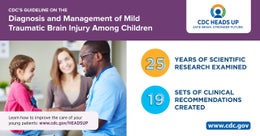
Whether you call it a concussion or a mild traumatic brain injury (mTBI), just don’t call it “getting your bell rung.” In some ways what we know about concussions has come a long way since “seeing stars” or “getting your bell rung” was the standard lingo for concussion and they came in grades of severity. The research continues. As what we know about concussions evolve, so do the guidelines. Guidelines, especially in the United States have most often focused on adults, but earlier this month the CDC has published concussion guidelines specific to the pediatric population, Centers for Disease Control and Prevention Guideline on the Diagnosis and Management of Traumatic Brain Injury Among Children.
According to the CDC (September 2018) the goal of this guideline is, “to provide a guideline based on a previous systematic review of the literature to obtain and assess evidence toward developing clinical recommendations for health care professionals related to the diagnosis and management of pediatric mTBI (p. E1).” The first of its kind in the United States. Other pediatric guidelines were published by the Ontario Neurotrauma Foundation (2014) for those who are interested.
I will highlight some of the key findings, but for those that are interested I encourage you to access and review the entire guideline along with the provider tools, training options (Heads Up) and parent and family resources available at the CDC website. The systematic review completed by the American Academy of Neurology on which the guidelines are based has also been published by JAMA Pediatrics.
To understand the guidelines and the recommendation grades, readers need to be familiar with the concept of Strength of Recommendation, a grading system used to provide an “overall score” for each recommendation. The recommendations used in this guideline is based on several factors including, the importance of outcome; benefit relative to harm; expected variation in patient preferences; financial burden, and the feasibility of the intervention. Recommendations are presented in 19 sets, focusing on three primary areas, diagnosis, prognosis and management/treatment.
The strength of recommendation levels are as follows:
- Level A: Recommendation should always be followed
- Level B: Recommendation usually should be followed
- Level C: Recommendation may sometimes be followed
- Level U: There is insufficient evidence to make a recommendation
- Level R: The intervention generally should not be done outside of a research setting
Diagnostic recommendations address use of computed tomography (CT), MRI, Single-photon emission CT (SPECT), radiograph (x-ray), neuropsychological tools, and serum markers. If imaging is necessary the preferred option is a CT, but that should be used with caution and based on clinical decision rules such PECARN and should be weighed carefully against the risks associated with use of CT. Additionally, there is no serum marker that can currently identify concussions. Symptom checklists, cognitive testing and other tools (SAC, SCAT) should be age-specific and appropriate for the pediatric population and should be used in combination. These guidelines are considered Level B evidence.
Prognostic recommendations address patient and family counseling, premorbid conditions, assessment of cumulative risk factors, role of assessment tools in prognosis, and interventions for those with poor prognosis. Generally, these prognostic recommendations emphasis that most pediatric concussions will resolve in 1 to 3 months, with each concussion being unique. The most common predictor of future concussion is previous concussion. While some epidemiology studies show that certain demographic groups may suffer symptoms for longer periods, generally prognosis cannot be predicted by any sign, symptom or assessment tool result. Again, many of these guidelines are considered level B evidence.
Management and treatment recommendations address patient and family education, cognitive and physical rest, aerobic activity, psychosocial support, return to school, posttraumatic headache management, vestibulo-oculomotor dysfunction management, sleep management, and cognitive impairment management. The most challenging area to provide a clear guideline based on the research seems to be in physical rest versus exercise. While it seems quite clear that initially physical and cognitive reset are recommended, research does not illuminate when to begin aerobic exercise in all cases. A graduated return to play is still recommended, ensuring that exercise does not recreate or exacerbate symptoms, but in the situation of prolonged symptoms, some research shows that exercise can improve recovery from the prolonged symptoms.
In my opinion the most important role of this guideline is that it aggregates the latest information related to the diagnosis, prognosis and management of pediatric concussions in one place. Being prepared as clinicians to address concussions is only as important as the patient and athlete education when it comes to recognizing and treating concussions effectively. Preparing athletes and parents to understand that if you’ve had/seen one concussion, you’ve had/seen one concussion. They are each unique, even in the same athlete. If this guideline better prepares clinicians to education parents and for parents to better understand concussions and how to care for them, then it’s worth the time it takes to complete such a broad systematic analysis.
Citation:
Lumba-Brown, A., Yeates, K.O., Sarmiento, K., et al. (2018). Centers for Disease Control and Prevention guidelines on the diagnosis and management of mild traumatic brain injury among children. JAMA Pediatrics. Published online doi: 101.1001/jamapediatrics.2018.2853.
DISCLAIMER: The content contained in this blog is for informational purposes only. The content is not intended to be a substitute for professional medical advice, diagnosis or treatment. Always seek the advice of your physician, athletic trainer, or other qualified health provider with any questions you may have regarding a medical condition. If you think you may have a medical emergency, call your doctor or 911 immediately.

